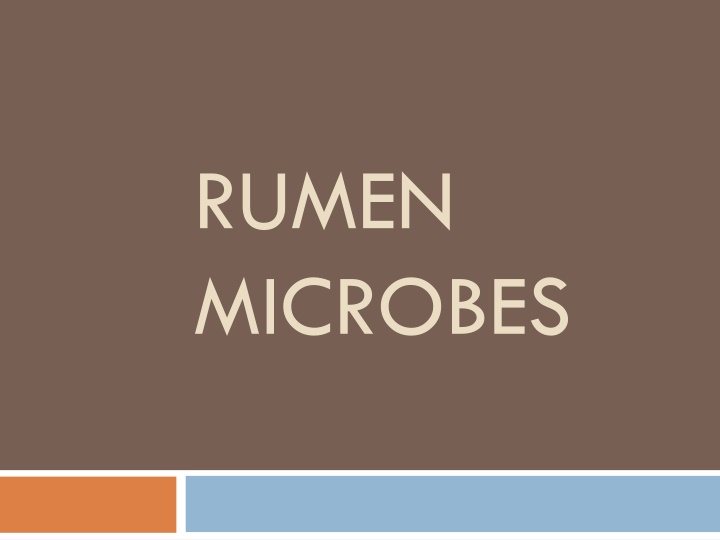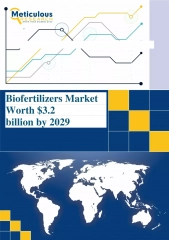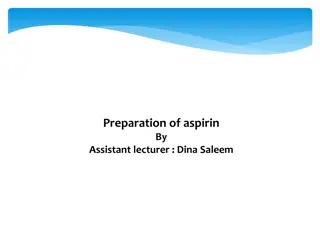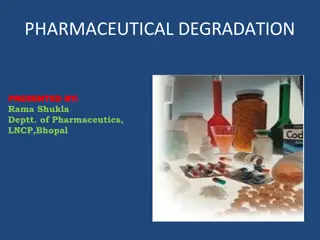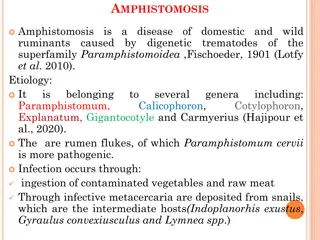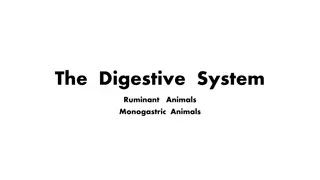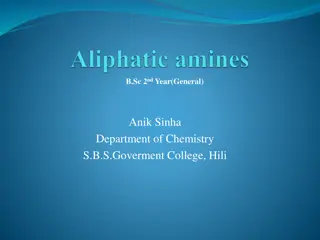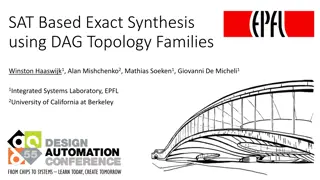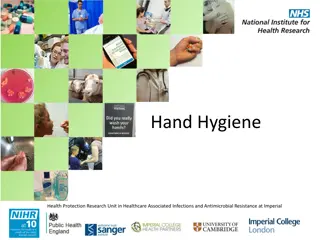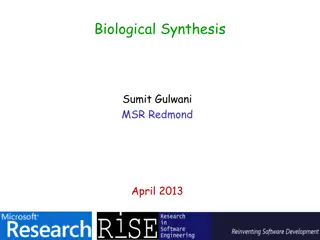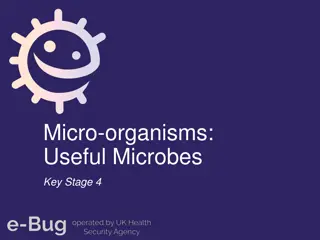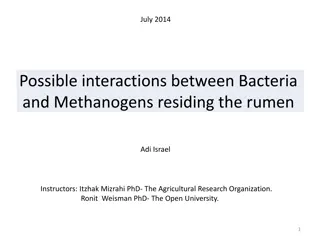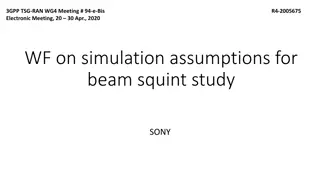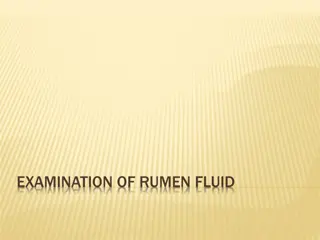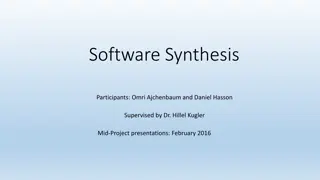Rumen Microbes: Degradation, Transport, Synthesis
Rumen microbes play a crucial role in the degradation, transport, and synthesis of nutrients in the digestive system of ruminant animals. These microbes carry out microbial fermentations with a short life cycle, forming a synergistic relationship based on substrates like starch and cellulose. Originating from the environment, rumen bacteria are predominantly anaerobic and capable of degrading cellulose, starch, soluble carbohydrates, proteins, and lipids. The microbial mass in the rumen, including eubacteria and archaebacteria, is crucial for amino acid synthesis and protein production. Different types of bacteria, such as true bacteria and facultative anaerobes, contribute to the intricate ecosystem of the rumen.
Download Presentation

Please find below an Image/Link to download the presentation.
The content on the website is provided AS IS for your information and personal use only. It may not be sold, licensed, or shared on other websites without obtaining consent from the author.If you encounter any issues during the download, it is possible that the publisher has removed the file from their server.
You are allowed to download the files provided on this website for personal or commercial use, subject to the condition that they are used lawfully. All files are the property of their respective owners.
The content on the website is provided AS IS for your information and personal use only. It may not be sold, licensed, or shared on other websites without obtaining consent from the author.
E N D
Presentation Transcript
RUMEN MICROBES
Rumen Microbes In charge of: Degradation Transport Synthesis
Microbial fermentations Short life cycle Synergistic relationship Based on substrates: Starch fermenter Amylolytic microbes Cellulose/roughage fermenter Cellulytic microbes
Rumen Microbes Originated from environment As the age at weaning : rumen development Sensitive to types of ingested feeds / pH Bacterial population 103- 105greater / ml of rumen fluid vs. protozoa Protozoa are very sensitive to pH
Rumen bacteria Mostly can t produce spore, anaerobic Degrade: Cellulose Starch Soluble carbohydrates Acidophilic Protein & other N compounds lipids I. II. III. IV. V. VI. Some produce CH4 (Co2 & H2)
Cont. ~ 50% or of microbial mass Most important for amino acid synthesis Leave the rumen (microbial protein) Two major types: Eubacteria & Archaebacteria Both from same predecessor 1- Archaebacteria: more primitive form; no O2 Methanogens 2- Eubacteria: rest of the rumen flora obligate & facultative anaerobes
Bacteria True bacteria: anaerobes; up to 1010/ml Facultative anaerobes: up to 107/ml Consume substrates produced by true anaerobes Consume O2; anaerobic environment Differentiated by: Substrate, obligate (O2) vs. facultative (O2 + other substrates), Gram + or - Shape/size, DNA sequencing, rRNA sequencing
Rumen bacteria Shape/size: cocci, rods, spirilla: 0.05 to 100 um Gram staining: Gram + : single, thick wall; purple Gram - : clusters, thinner walls; light pink & Mycoplasma
substrates 1- utilizes specific substrates Ruminobacter amylophilus: starch Fibrobacter succinogens: mainly cellulose 2- not so specific in their substrates Butyrivibrio fibrosolvens: starch, cellulose, pectin Selenomonas ruminantium: several substrates; synthesize propionate
Classifying rumen bacteria by energy source Cellulolytic bacteria Cellulose Primary constituent of plant cell walls A chain of glucose units bound by beta-1,4-linkages Can only be digested by microorganisms Digestibility determined by lignification Common cellulolytic bacteria Ruminococcus flavefaciens Ruminococcus albus Fibrobacter succinogens Butyrvibrio fibrisolvens Clostridium lochheadii
Rumen Bacteria 1- Prevotella spp. -Numerous -Degrades starch, xylan, pectin but not cellulose -Protein degradation -produce acetate, propionate, succinate
Bacteria 2- Ruminobacter amylophilus -Also called bacteroides amylophilus -High concentrate rations; dominant spp. hydrolyzing starch (secrete amylase) -Important in degrading proteins
Bacteria 3-Fibrobacter succinogens -Also considered Bacteroides -Cellulolytic: breaks down cellulose, cellobiose, glucose -Antibiotic resistant -Easily decreases in # in response to 2o metabolites (e.g., phenolic compounds)
Bacteria 4- Anaerovibrio lipolytica -Lipid hydrolysis -Lactate utilization - More predominant in the rumen: diet containing oil/fat > more concentrate > forage diet - Ferment TAG, PL, glycerol
Bacteria 5- Selenomonas ruminantium -When fed concentrate diets, most numerous (up to 50%) -Substrates: maltose, cellobiose, xylose, galactose -Products: propionate, lactate
Bacteria 6- Megasphaera elsdinii - Concentrate diets; young ruminants - Major contributor of lactate (up to 75%) - Also branched VFA
Bacteria 7- Ruminococcus spp. R. flavefaciens R. albus Major fibrolytic (cellulolytic) bacteria; need NH3 for optimum growth
Bacteria 8- Streptococcus bovis -Substrate: starch -When too much grain: lactic acidosis -Very rapid growth -Acid-tolerant -also survive on forage-based diets (uses water-soluble semi-complex carbohydrates)
Bacteria 9-Butyrovibrio fibroslovens - Major fibrolytic - Substrates: starch, pectin, xylan - Produce butyrate - Also demonstrates proteolytic activity
Bacteria 10- Clostridium spp. -Originate from silage -Fibrolytic (cellulose) -Substrates: cellulose, starch, pectin, xylan -minor proteolytic
Bacteria 11-Lactobacillus spp. -Young ruminants: milk, concentrate -Acid tolerant -Can cause lactic acidosis
Growth requirements of cellulolytic bacteria pH 6.0-7.0 Will not grow at pH < 6.0 Reasons: NH3* Branched chain VFA* Leucine > Isovaleric acid Isoleucine > 2 methyl-butyric acid Valine > Isobutyric acid Phenolic acids* Phenylalanine > Phenylacetic acid Phenylalanine or Cinnamic acids > 3-Phenylpropionic acid CO2 as HCO3* S- as Cysteine or Sulfate Depletion of HCO3 VFAs are inhibitory Destruction of membrane potential
Fermentation end-products of cellulolytic bacteria Cellobiose Acetic acid* Butyric acid Not normally found; Used by other bacteria CO2* H2* Ethanol* Succinic acid* Formic acid Lactic acid *Major end-products
Overall Hydrogen disposal: reducing factors get oxidized CH4 mainly from H2 and CO2 True bacteria??? Based upon age, environment, diet, # 103 to 109/ml
Rumen protozoa Large (..er) organism (5-250 um) Oval/spheric shape Two major groups: 1- Ciliates (much more numerous) 2- Flagellates 105 to 106/ml, 40-50% of biomass
Rumen protozoa Anaerobic Morphologically: Endodiniomorphida Holotricha Degrade: I. Cellulose (epidinium) II. Starch (store as amylopectin) III. Soluble carbohydrates (Glu, Fru, Suc, and Cellobiose) IV. Lipids (also bio-hydrogenation) less involved w/ proteins degradation ( ~ 10%)
Most are ciliated Families Isotrichidae (Holotrichs) Cilia over entire body Genuses Isotricha Dasytricha Orphryscolidae (Oligotrichs) Cilia in mouth region Genuses Entodinium Eudiplodinium Epidinium Ophryoscolex
Protozoa Greater digestibility Better AA content but not more than 25% of Microbial Protein (MP) Long residency Fibrolytic, consume bacteria, produce VFA N recycling Prevents acidosis: slow fermentation of starch
The need for protozoa in the rumen Protozoa are not necessary for the animal (Commensalism) Disadvantages of protozoa Increased rumen protein turnover Reduced efficiency of protein use Increased CH4 production Development of more virulent strains of pathogenic bacteria Advantages of protozoa Increased cellulose digestion 25 33% of total cellulose digestion Mechanisms More active than bacteria? Provide NH3 to bacteria Remove O2 Slower fermentation of starch and sugars Greater VFA production Increased transport on conjugated linoleic acid (CLA) and trans-11 (18:1) fatty acid to duodenum and meat and milk
Protozoa Entodinio-morphid protozoa: largest # Entodinium: smallest & simplest but most numerous - Genus Diplodinium - Genus Eudiplodinium - Genes Ostracodinium - Genus Polyplastron
Mixed rumen ciliates Eu: Eudiplodinium Ep: Epidinium En: Entodinium D: Daystrichia O: Ostracodinium El: Enoplastron
Protozoa The Holotrich Isotricha intestinalis Isotricha prostoma Isotricha ruminantium # when dietary soluble carbohydrates along with feeding forage-based ration (up to 20% of ciliate)
Rumen flagellates Chilomastix caprae Monocercomonoides caprae Monoceromonas ruminantium Tetratrichomonoas butureyi Pentatrichomonas hominis Relatively small in size: 5-14 um in length
Rumen flagellates Mean generation time: ~5-6 hr More in young ruminants, before development of ciliate Less than 105/ml Utilize only soluble carbohydrates
Defaunating the rumen Isolation from birth Using detergents (e.g., CuSO4) Using bioactive agents: saponins, tannins FA: med-chain saturated; LC-unsaturated Removing rumen contents and washing the rumen with formaldehyde solution
Net effects of defaunation Increased daily gains Improved feed efficiency Decreased OM and cellulose digestion Increased total and microbial protein flow to the duodenum Increased pH on high concentrate diets, but decreased pH on high forage diets Increased production of propionic acid and decreased production of butyric acid Increased rumen volume and liquid outflow rate
Net effects of defaunation Complete removal: reduced digestibility of fibers in the rumen May be associated w/ gain weight change in response is smaller than fiber digestion N flow to SI
Establishment of the rumen microbial population At birth, rumen has no bacteria (???) Normal pattern of establishment Appear 5-8 hours week week week 1 week 1 week 3 weeks - Peak 4 days 3 weeks 5 weeks 6 weeks 6-10 weeks 12 weeks 5-9 weeks 9-13 weeks Microorganisms E. coli, Clostridium welchii, Streptococcus bovis Lactobacilli Lactic acid-utilizing bacteria Amylolytic bacteria Prevotella-wk 6 Cellulolytic and Methanogenic bacteria Butyrvibrio-wk 1 Ruminococcus-wk 3 Fibrobacter-wk 1 Proteolytic bacteria Protozoa Normal population
Uptake of particulate matter Entodinomorphid: engulfing feed particles Epidinia: attaching, cellulases release, engulfing Polyplastron: uptake w/o prior attachment Soluble compounds are taken up by ALL protozoa
Factors affecting establishment of population Presence of organisms Normally population is established through animal-to-animal contact Bacteria may establish without contact with mature ruminants Establishment of protozoa requires contact with mature ruminants Favorable environment Substrates and intermediates Increased rumen pH Digesta turnover
Altering the rumen population Diet High forage > High pH, cellulose, hemicellulose, sugars > High cellulolytic and hemicellulolytic bacteria > High methanogens > High protozoa High concentrate> Low pH, high starch > Low cellulolytic and hemicellulolytic bacteria > High amylolytic bacteria > Low methanogens > Low protozoa, primarily oligotrichs Buffers Same as high forage Antibiotics Ionophores Microbial inoculants
Ionophore & rumen microbial population Ionophores Monensin Lasalocid Laidlomycin Actions Create pores in membranes of Gram + bacteria Allows potassium to exit and hydrogen to enter cells Bacteria affected Inhibits Ruminococcus albus Decreased acetate, formate and Ruminococcus flavefaciens Butyrvibrio fibrisolvens Streptococci Lactobacilli Increases Fibrobacter succinogens Prevotella ruminicola Selenomonas ruminantium Effects methane Decreased lactate Increased propionate
Net results of feeding ionophores Increased propionate Reduced protein degradation Reduced deamination Reduced methane production Reduced lactate production
Use of microbial inoculants Dosing with lactate-utilizing bacteria can reduce lactic acid build up in rumen Difficult to do long-term Antagonistic environment Difficult to get enough organisms Considerable gene exchange Mechanisms Transformation Conjugation Transduction Favorable conditions for gene transfer High population Intimate cell-to-cell contact Supply of phages Extrachromosal plasmid DNA Transient non-rumen bacteria
